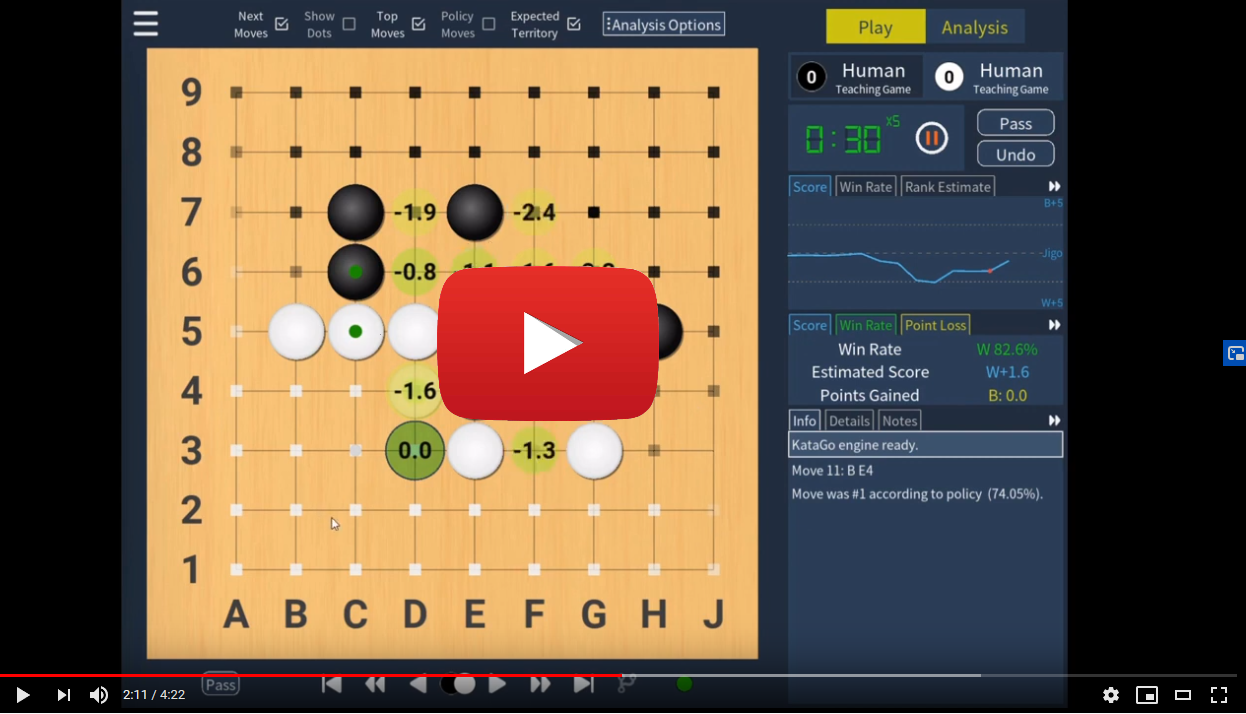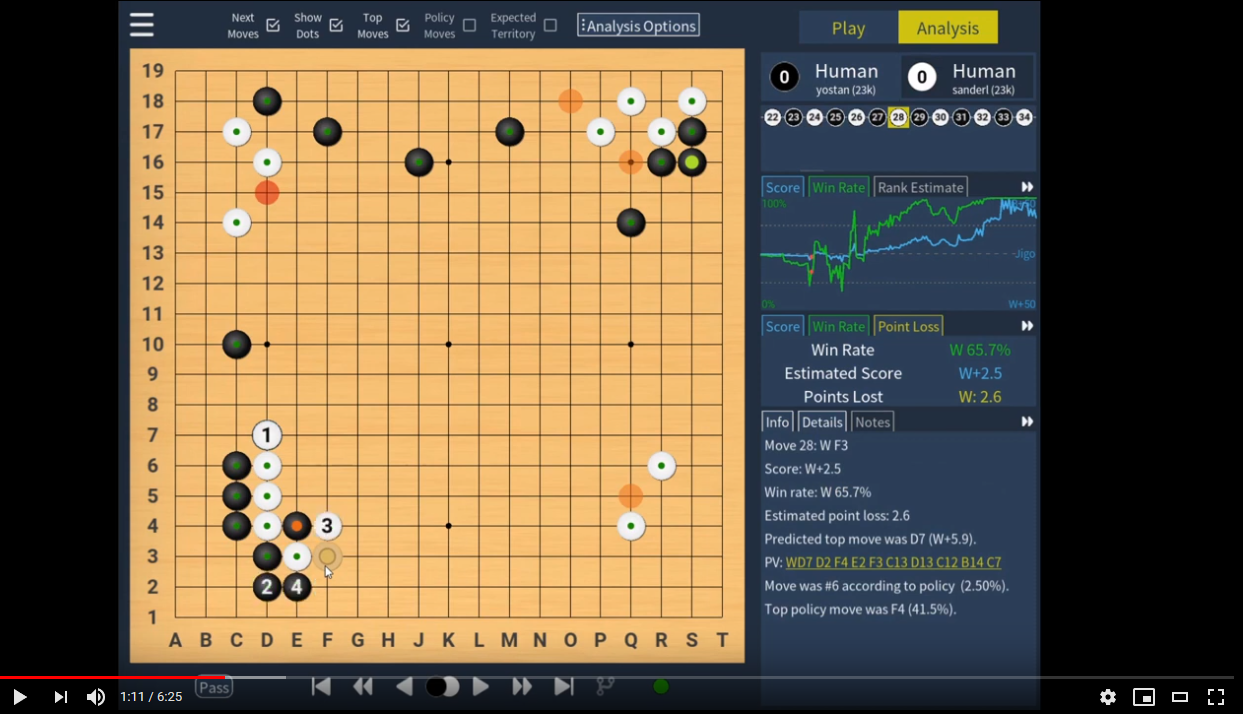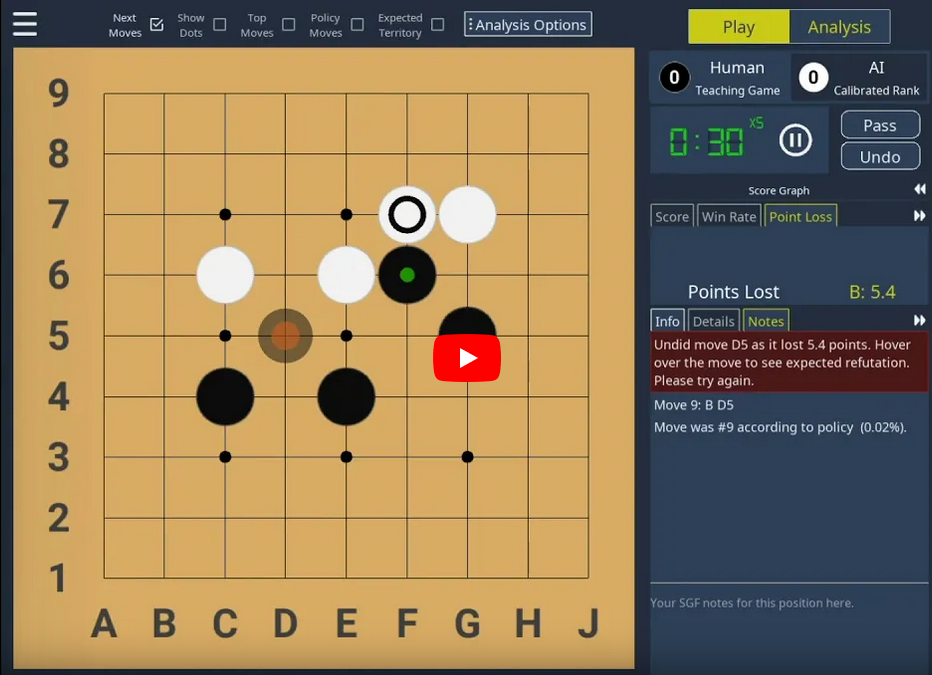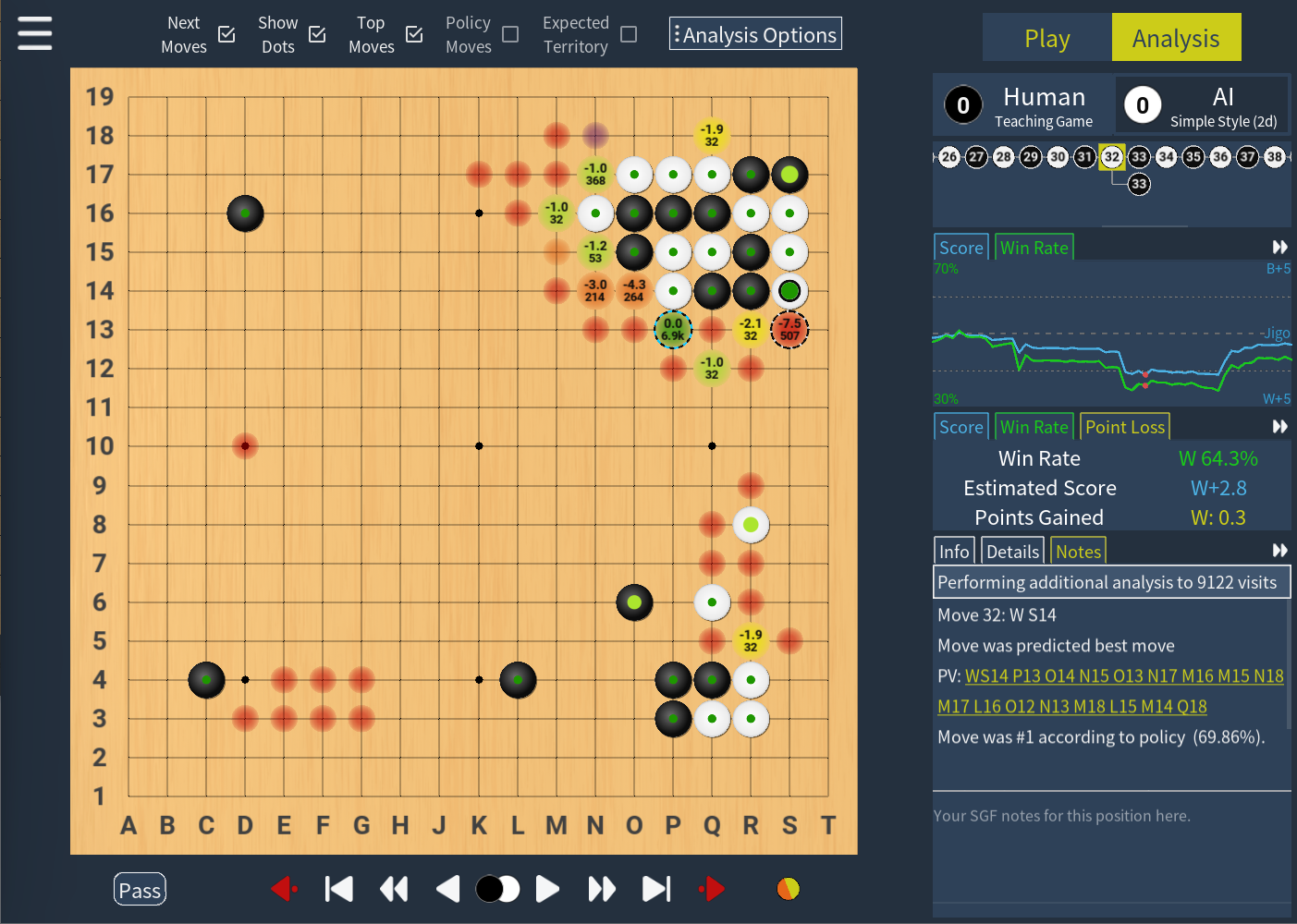Go/Baduk/Weiqi playing and teaching app with a variety of AIs
Project description
KaTrain
Introduction
KaTrain is a tool for analyzing and playing go with AI feedback from KataGo.
The original idea was to give immediate feedback on the many large mistakes we make in terms of inefficient moves, but has since grown to include a wide range of features, including:
- Review your games to find the moves that were most costly in terms of points lost.
- Play against AI and get immediate feedback on mistakes with option to retry.
- Play against a wide range of weakened versions of AI with various styles.
- Play against a stronger player and use the retry option instead of handicap stones.
- Automatically generate focused SGF reviews which show your biggest mistakes.
Previews and Youtube Videos
Play against an AI Teacher
Analyze your games
YouTube videos
| New Features in v1.4 | Analysis Tutorial | Teaching Game Tutorial |
|---|---|---|
 |
 |
 |
Installation
- See the releases page for downloadable executables for Windows.
- Alternatively use
pip3 install -U katrainto install the latest version from PyPI on any 64-bit OS. - This page has detailed instructions for Window, Linux and MacOS, as well as troubleshooting and setting up KataGo to use multiple GPUs.
Configuring KataGo
KaTrain comes pre-packaged with a working KataGo (OpenCL version) for Windows and Linux operating systems, and the 15 block neural network.
To change the model, open 'General and Engine settings' in the application and 'Download models'. You can then select the model you want from the dropdown menu.
To change the katago binary, e.g. to the Eigen/CPU version if you don't have a GPU, click 'Download KataGo versions'. You can then select the KataGo binary from the dropdown menu.
Finally, you can override the entire command used to start the analysis engine, which can be useful for connecting to a remote server. Do keep in mind that KaTrain uses the analysis engine of KataGo, and not the GTP engine.
Play against AI
- Select the players in the main menu, or under 'New Game'.
- In a teaching game, KaTrain will analyze your moves and automatically undo those that are sufficiently bad.
- When playing against AI, note that the "Undo" button will undo both the AI's last move as well as yours.
Instant feedback
The dots on the move indicate how many points were lost by that move.
- The colour indicates the size of the mistake according to KataGo
- The size indicates if the mistake was actually punished. Going from fully punished at maximal size, to no actual effect on the score at minimal size.
In short, if you are a weaker player you should mostly focus on large dots that are red or purple, while stronger players can pay more attention to smaller mistakes. If you want to hide some colours on the board, or not output details for them in SGFs,you can do so under 'Configure Teacher'.
AIs
This section describes the available AIs.
In the 'AI settings', settings which have been tested and calibrated are at the top and have a lighter color, changing these will show an estimate of rank. This estimate should be reasonably accurate as long as you have not changed the other settings.
- Recommended options for serious play include:
- KataGo is full KataGo, above professional level. The analysis and feedback given is always based on this full strength KataGo AI.
- Calibrated Rank Bot was calibrated on various bots (e.g. GnuGo and Pachi at different strength settings) to play a balanced game from the opening to the endgame without making serious (DDK) blunders. Further discussion can be found here and here.
- Simple Style Prefers moves that solidify both player's territory, leading to relatively simpler moves.
- ScoreLoss is KataGo analyzing as usual, but choosing from potential moves depending on the expected score loss, leading to a varied style with mostly small mistakes.
- Policy uses the top move from the policy network (it's 'shape sense' without reading).
- Policy Weighted picks a random move weighted by the policy, leading to a varied style with mostly small mistakes, and occasional blunders due to a lack of reading.
- Blinded Policy picks a number of moves at random and play the best move among them, being effectively 'blind' to part of the board each turn. Calibrated rank is based on the same idea, and recommended over this option.
- Options that are more on the 'fun and experimental' side include:
- Variants of Blinded Policy, which use the same basic strategy, but with a twist:
- Local Style will consider mostly moves close to the last move.
- Tenuki Style will consider mostly moves away from the last move.
- Influential Style will consider mostly 4th+ line moves, leading to a center-oriented style.
- Territory Style is biased in the opposite way, towards 1-3rd line moves.
- KataJigo is KataGo attempting to win by 0.5 points, typically by responding to your mistakes with an immediate mistake of it's own.
- Variants of Blinded Policy, which use the same basic strategy, but with a twist:
The Engine based AIs (KataGo, ScoreLoss, KataJigo) are affected by both the model and choice of visits and maximum time, while the policy net based AIs are affected by the choice of model file, but work identically with 1 visit.
Further technical details and discussion on these AIs can be found on this thread at the life in 19x19 forums.
Analysis
Analysis options in KaTrain allow you to explore variations and request more in-depth analysis from the engine at any point in the game.
Keyboard shortcuts are shown with [key].
-
[Tab]: Switch between analysis and play modes.
- AI moves, teaching mode and timers are suspended in analysis mode.
- The state of the analysis options and right-hand side panels and options is saved independently for 'play' and 'analyze', allowing you to quickly switch between a more minimalistic 'play' mode and more complex 'analysis' mode.
-
The checkboxes at the top of the screen:
- [q]: Child moves are shown. On by default, can turn it off to avoid obscuring other information or when wanting to guess the next move.
- [w]: Show all dots: Show all evaluation dots instead of the last few.
- You can configure how many are shown with this setting off, and whether they are shown for AIs under 'Configure Teacher'.
- [e]: Top moves: Show the next moves KataGo considered, colored by their expected point loss. Small/faint dots indicate high uncertainty and never show text (lower than your 'fast visits' setting). Hover over any of them to see the principal variation.
- [r]: Policy moves: Show KataGo's policy network evaluation, i.e. where it thinks the best next move is purely from the position, and in the absence of any 'reading'. This turns off the 'top moves' setting as the overlap is often not useful.
- [t]: Expected territory: Show expected ownership of each intersection.
-
The analysis options available under the 'Analysis' button are used for deeper evaluation of the position:
- [a]: Deeper analysis: Re-evaluate the position using more visits, usually resulting in a more accurate evaluation.
- [s]: Equalize visits: Re-evaluate all currently shown next moves with the same visits as the current top move. Useful to increase confidence in the suggestions with high uncertainty.
- [d]: Analyze all moves: Evaluate all possible next moves. This can take a bit of time even though 'fast_visits' is used, but can be useful to see how many reasonable next moves are available.
- [f]: Find alternatives: Increases analysis of current candidate moves to at least the 'fast visits' level, and request a new query that excludes all current candidate moves.
- [g]: Find local responses: Searches within 5 spaces of the last move only.
- [spacebar]: Turn continuous analysis on/off. This will continuously improve analysis of the current position, similar to Lizzie's 'pondering', but only when there are no other queries going on.
- [enter] AI move. Makes the AI move for the current player regardless of current player selection.
Keyboard and mouse shortcuts
In addition to shortcuts mentioned above and those shown in the main menu:
- [Shift]: Open the main menu.
- [~] or [ ` ] or [m]: Cycles through more minimalistic UI modes.
- [p]: Pass
- [b]: Pause/Resume timer
- [arrow left] or [z]: Undo move. Hold alt for 10 moves at a time, or ctrl to skip to the start.
- [arrow right] or [x]: Redo move. Hold alt for 10 moves at a time, or ctrl to skip to the start.
- [arrow up/down] Switch branch, as would be expected from the move tree.
- [n] As in clicking the red arrow, go to one move before the next mistake (orange or worse) by a human player.
- [home/end] Go to the beginning/end of the game.
- [scroll up]: Undo move. Only works when hovering the cursor over the board.
- [scroll down]: Redo move. Only works when hovering the cursor over the board.
- [click on a move]: See detailed statistics for a previous move, along with expected variation that was best instead of this move.
- [double-click on a move]: Navigate directly to just before that point in the game.
- [Ctrl-V]: Load SGF from clipboard and do a 'fast' analysis of the game (with a high priority normal analysis for the last move).
- [Ctrl-C]: Save SGF to clipboard.
FAQ
- The program is running too slowly. How can I speed it up?
- Adjust the number of visits or maximum time allowed in the settings.
- KataGo crashes with out of memory errors, how can I prevent this?
- Try using a lower number for
nnMaxBatchSizeinKataGo/analysis_config.cfg, and avoid using versions compiled with large board sizes. - If still encountering problems, please start KataGo by itself to check for any errors it gives.
- Note that if you don't have a GPU, or your GPU does not support OpenCL, you should use the 'eigen' binaries which run on CPU only.
- Try using a lower number for
Support / Contribute
- Ideas, feedback, and contributions to code or translations are all very welcome.
- For suggestions and planned improvements, see open issues on github to check if the functionality is already planned.
- I am looking for contributors of more translations of both this manual and the program itself. The best way to help with this is to contact me on discord.
- You can contact me on discord (Sander#3278), KakaoTalk or Reddit to get help, discuss improvements, or simply show your appreciation.
- You can also donate to the project through Github Sponsors.
Project details
Release history Release notifications | RSS feed
Download files
Download the file for your platform. If you're not sure which to choose, learn more about installing packages.
Source Distribution
Built Distribution
File details
Details for the file KaTrain-1.6.0.tar.gz.
File metadata
- Download URL: KaTrain-1.6.0.tar.gz
- Upload date:
- Size: 65.4 MB
- Tags: Source
- Uploaded using Trusted Publishing? No
- Uploaded via: twine/3.2.0 pkginfo/1.6.1 requests/2.25.0 setuptools/47.1.0 requests-toolbelt/0.9.1 tqdm/4.53.0 CPython/3.7.9
File hashes
| Algorithm | Hash digest | |
|---|---|---|
| SHA256 | 4ae85e048a093734301761f979f3fd57c5304c826242a7c5897febb1ed7c36f4 |
|
| MD5 | 53924dcd34697d24078e82c9b4c7a26f |
|
| BLAKE2b-256 | 7beb540c042797fcf2b80b0a3fe03d78c7b726a0e55c52eb2109528db7669d31 |
File details
Details for the file KaTrain-1.6.0-py3-none-any.whl.
File metadata
- Download URL: KaTrain-1.6.0-py3-none-any.whl
- Upload date:
- Size: 65.5 MB
- Tags: Python 3
- Uploaded using Trusted Publishing? No
- Uploaded via: twine/3.2.0 pkginfo/1.6.1 requests/2.25.0 setuptools/47.1.0 requests-toolbelt/0.9.1 tqdm/4.53.0 CPython/3.7.9
File hashes
| Algorithm | Hash digest | |
|---|---|---|
| SHA256 | 4bc8f10dc7fb251c0bec357c06cfb420c48e846bc8623d1780228cf03a134749 |
|
| MD5 | 0cbf236f24f28bb70240eee96f3affcf |
|
| BLAKE2b-256 | 9780c800648fc9d4759d1b2013bbcee68fe9b4b329489a169c03395aee4cfe1d |





























